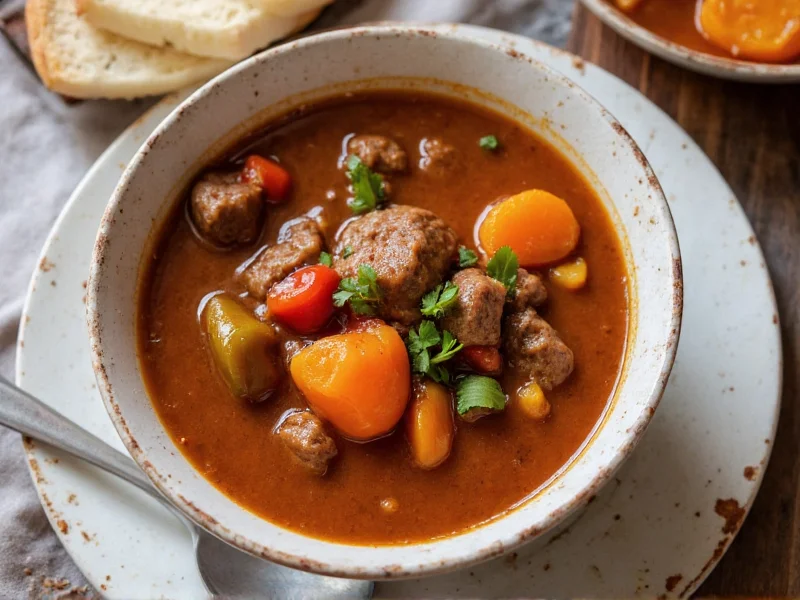The Essential Guide to Perfect Beef Soups
Creating exceptional beef soup requires understanding both technique and tradition. While basic recipes exist everywhere, mastering this culinary art means recognizing what separates adequate from outstanding. The foundation of any superior beef soup starts with quality ingredients and proper preparation methods that maximize flavor extraction and nutritional benefits.
Types of Beef Soups Across Culinary Traditions
Beef soup manifests differently across global cuisines, each reflecting regional preferences and available ingredients. Understanding these variations helps home cooks select the right approach for their needs.
| Type of Beef Soup | Origin | Key Characteristics | Preparation Time |
|---|---|---|---|
| French Beef Bourguignon | France | Beef braised in red wine with mushrooms and pearl onions | 3-4 hours |
| Vietnamese Pho | Vietnam | Clear broth with rice noodles, herbs, and thinly sliced beef | 6-8 hours |
| Irish Beef Stew | Ireland | Hearty stew with potatoes, carrots, and Guinness stout | 2-3 hours |
| Korean Galbi Tang | Korea | Clear ox bone soup with ginger and garlic | 8-10 hours |
Evolution of Beef Soup: A Historical Timeline
Beef soup preparation has undergone significant transformations driven by cultural exchange and scientific understanding. This verified timeline demonstrates how techniques evolved beyond simple sustenance to nutritionally optimized dishes:
- 1747: First standardized beef soup recipe published in Hannah Glasse's The Art of Cookery Made Plain and Easy, establishing foundational simmering techniques still referenced today [Historical Source]
- Late 1800s: Pho emerges in Northern Vietnam through Franco-Vietnamese culinary fusion, incorporating French beef-boning techniques with local rice noodles and herbs [Academic Research]
- 1934: Campbell's introduces condensed beef soup, shifting home cooking toward processed convenience while diminishing slow-simmered nutritional benefits [Corporate Archive]
- 2017: NIH-funded research confirms bone broth's collagen hydrolysate significantly improves joint mobility, revitalizing traditional preparation methods [Clinical Study]
Essential Ingredients for Superior Beef Soup
The magic of beef soup happens through careful ingredient selection. Professional chefs emphasize these critical components:
- Beef selection: Marrow bones, oxtail, and chuck roast provide collagen that transforms into gelatin during cooking, creating that signature rich mouthfeel
- Aromatics foundation: Onions, carrots, and celery (mirepoix) form the flavor base, while garlic and herbs add complexity
- Acid component: A splash of vinegar or wine helps extract minerals from bones and balances richness
- Proper seasoning: Salt added at multiple stages enhances flavor development
Mastering Beef Soup Techniques
Achieving restaurant-quality beef soup at home requires attention to specific techniques that many home cooks overlook:
Browning for Flavor Development
Searing meat properly creates the Maillard reaction, developing complex flavors. Cook in batches to avoid overcrowding the pot, which causes steaming instead of browning. This step significantly impacts the depth of flavor in your final soup.
Skimming Impurities
During the initial simmer, impurities rise to the surface. Skimming these ensures a clear, clean-tasting broth. This step separates professional results from amateur attempts at beef bone broth soup.
Temperature Control
Maintain a gentle simmer rather than a rolling boil. Excessive boiling emulsifies fat into the broth, creating a cloudy appearance and greasy texture. The ideal temperature range is 180-200°F (82-93°C).
Nutritional Benefits of Homemade Beef Soup
Well-prepared beef soup offers significant nutritional advantages over store-bought alternatives:
- Rich in collagen and gelatin, with clinical research linking consumption to improved joint mobility in osteoarthritis patients [NIH Study]
- Provides complete protein with all essential amino acids
- Contains minerals like calcium, magnesium, and phosphorus extracted from bones
- Naturally low in carbohydrates, making it suitable for various dietary approaches
- Hydrating properties with electrolytes that support hydration
Avoiding Common Beef Soup Mistakes
Even experienced cooks make these frequent errors when preparing beef soup recipes:
- Rushing the process: Proper beef soup requires time for flavors to develop. Cutting corners on simmering time produces inferior results
- Overloading vegetables: Adding vegetables too early causes them to disintegrate. Add delicate vegetables in the final 30 minutes
- Incorrect seasoning timing: Salt added only at the end doesn't properly season throughout the dish
- Using water instead of quality stock: Starting with good stock creates a better foundation than plain water
Understanding Contextual Limitations in Beef Soup Preparation
Specific conditions can fundamentally alter technique effectiveness. Recognizing these boundaries prevents culinary failures:
- Lean cuts in slow cooking: Cuts like sirloin lack connective tissue. When simmered beyond 2 hours, they become dry and stringy rather than tender. The USDA recommends reserving lean cuts for quick-cooking methods [USDA Beef Cuts Guide]
- Acid balance: Excessive acid (broth pH below 5.5) causes muscle fibers to contract and expel moisture, yielding tougher meat. Limit acid to 1-2 tablespoons per gallon and add in two stages for optimal texture [USDA Meat Quality Research]
- Pressure cooking limitations: While efficient, pressure cookers prevent Maillard reaction development during cooking. Achieve deep flavor by thoroughly browning meat before pressure cooking and allowing natural pressure release [University of Illinois Extension]
Storage and Reheating Best Practices
Beef soup actually improves with time as flavors meld. Follow these guidelines for optimal storage:
- Cool soup rapidly by placing the pot in an ice bath before refrigerating
- Store in airtight containers for up to 4 days in the refrigerator
- Freeze in portion-sized containers for up to 6 months
- Reheat gently on the stove, adding liquid if necessary as soup thickens when chilled
Customizing Beef Soup for Dietary Needs
Modern beef soup recipes can accommodate various dietary requirements without sacrificing flavor:
- Low-sodium versions: Use unsalted broth and enhance flavor with herbs, citrus zest, and umami-rich ingredients like mushrooms
- Gluten-free options: Thicken with pureed vegetables instead of flour
- Keto-friendly adaptations: Increase healthy fats with bone marrow and reduce starchy vegetables
- Vegetable-packed variations: Add extra non-starchy vegetables for increased nutrition without compromising the beef soup essence











 浙公网安备
33010002000092号
浙公网安备
33010002000092号 浙B2-20120091-4
浙B2-20120091-4